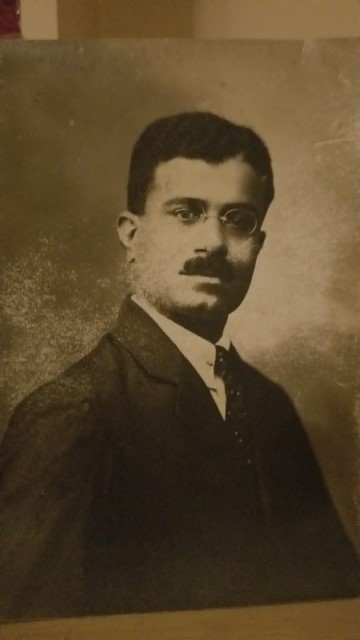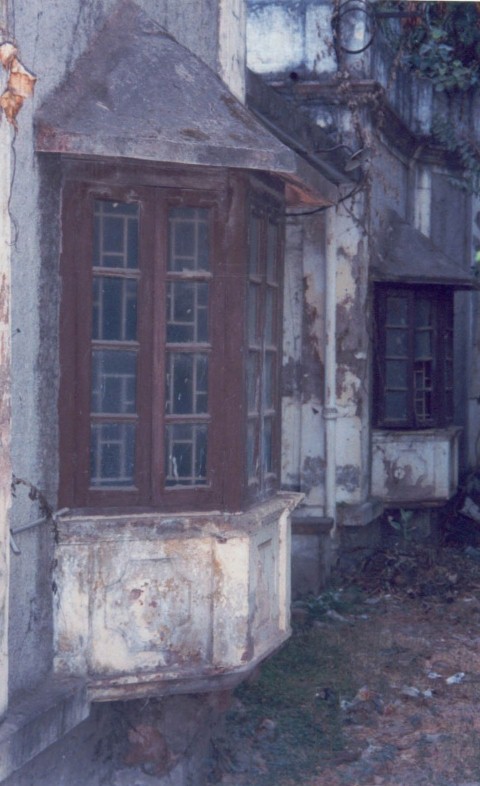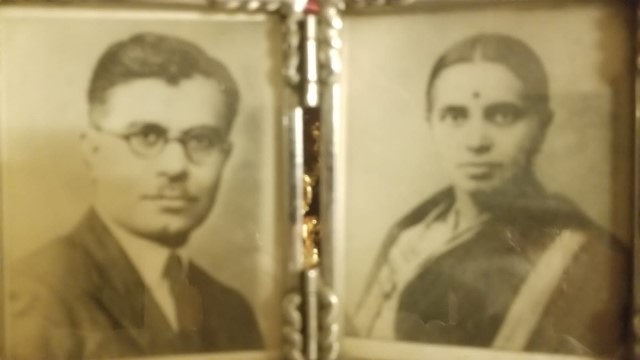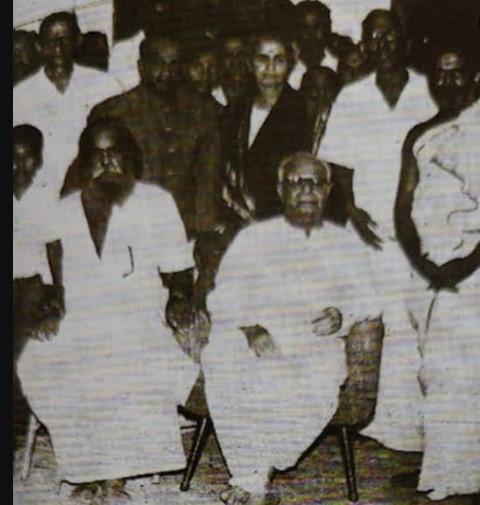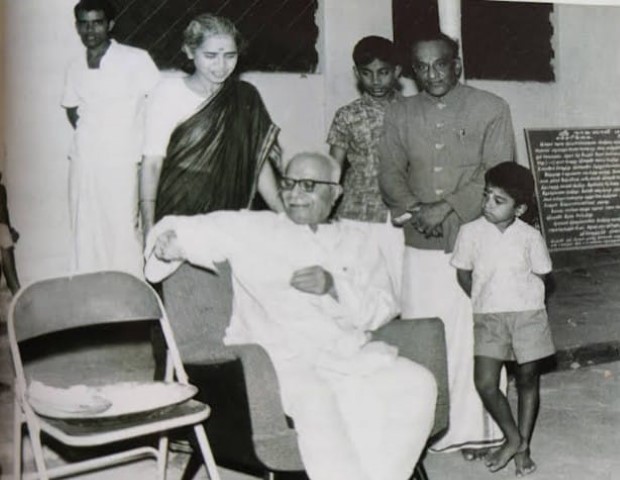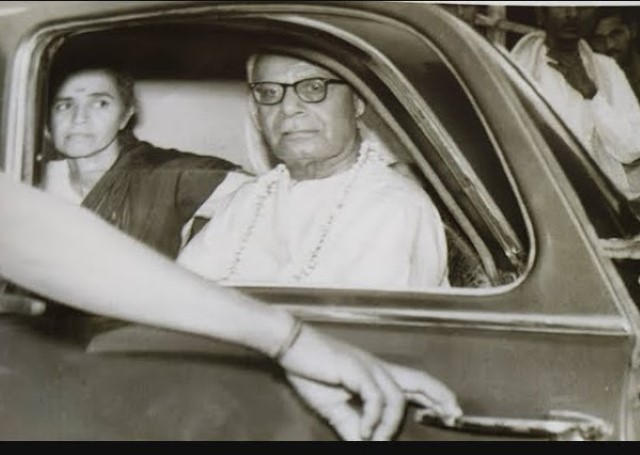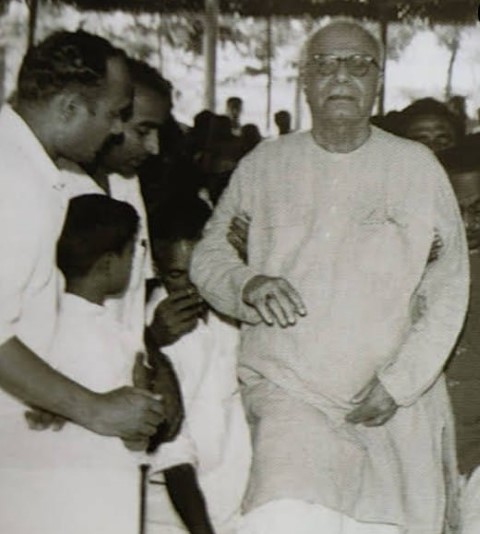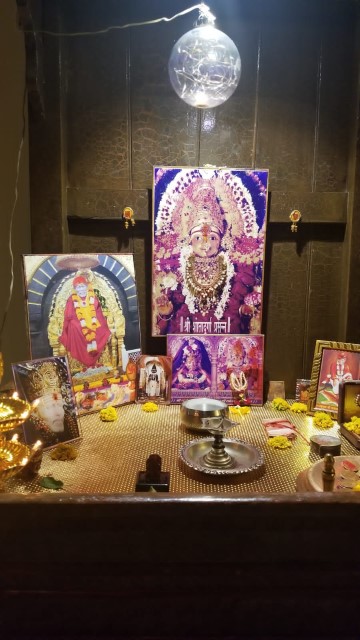|
Sri M. B Rege was an ex-Judge of the Indore High Court. Sri Rege’s special qualification and reason for getting such great benefit from Baba was the way in which he developed his religious side from the beginning. Durga of Goa was the family Goddess, and he was keen on her worship from infancy. Later, that is, in his eighth year, he had Upanayanam, Gayatri and Sandhya and he observed these strictly. He was led then from Durga to Narayana or Vishnu. The Ravi Varma picture of Dhuruva Narayana had a very deep impression on him. He meditated on that picture. He however found that when meditating on Vishnu in that picture, Dhuruva’s figure constantly intruded and disturbed his concentration. So, he cut out Dhuruva’s figure and began to pray that Vishnu should place him in the position of Dhuruva, which he had cut out – that is, he wanted laya at the feet of God. Along with his devotional meditation, he was practising, as a boy, both Asana and Pranayama, and could pass one or two hours sitting in Padmasana or Siddhasana, and for over 15 minutes a single picture or idea used to occupy in his mind. All this he did without a Guru. Breath control also he succeeded in. Later he could regulate or even stop his heart beat. This concentration on Vishnu and prayers had its effect in his 21st year, when his practice and prayer bore fruit.
M.B.Rege in his Youth Days
House of M.B.Rege One night in 1910, he had three successive trance visions or dreams. In the first, he found himself in the lying down posture, that is, in bed and noticed a change. The body lay separate from him and he stood out and looking on the body. So, he was not the body and in front of him the gracious Vishnu Narayana figure was standing. This suggested that by the grace of Vishnu to whom he prayed, the first essential step in one’s spiritual progress, namely, getting over the delusion that we are the body, Dehatma Buddhi had started. An hour later, he had the next experience. Again, his body lay on the bed, and he was still standing outside it. Vishnu Narayana also was standing in front of him. But this time, there was another figure standing next to Vishnu Narayana and Sri Vishnu pointing to that figure told him, ‘This Sai Baba of Shirdi is your man; you must resort to him.’ This was the introduction of the first great step in all progress, namely, the securing of a Guru. Strangely enough, by God’s grace he was getting over the Dehatma Buddhi, but at the same time to make it ripen and lead him to the fullest success, the Guru was pointed out to him, the Guru who was to seize him for life. And here the second vision ended. The third started an hour or so later. Here the first feeling he had was that he was travelling somewhere, evidently in the air. He came to a village and asked some one what that village was. He learnt that it was Shirdi. Then, he asked, ‘If it is Shirdi, is there a Sai Baba here?’. He was told, ‘Yes; go and see’. He was taken to the Mosque, and there he saw Sai Baba sitting with legs outstretched. In the vision, at once he approached and reverently placed his head on Baba’s feet. But Baba got up and said, ‘Do you take my darshan? I am your debtor; I must take your darshan’. And Baba placed his head on Rege’s feet. These visions ended. They produced a powerful impression. Sai Baba began to grow up in his soul. He felt a strong impulse to go to Shirdi. But he was still a student. After some time, he did succeed in going to Shirdi, Rege went and prostrated, placing his head on Baba’s feet. Baba said, ‘What! Do you worship a man?’ At once, the rebuff struck Rege, and struck him keenly. He retreated and went to the mandap and sat there. How long he sat, he did not know. He was simply stunned. No doubt he had, as a student, caught the modern and stoic idea that a man should not be worshipped. He was puzzled. His dream told him Baba was to accept him and be his Guru. But there he was getting a rebuff. It is true that his idea on the subject of man worship had not become quite clear and crystallized. But what was he to do? He was determined, as he had come to Shirdi to see whether Baba would accept him or not. So, he sat on dazed till the entire crowd dispersed. Suddenly he opened his eyes and saw that Baba was alone at the Mosque and there was no one with him. That was in the afternoon. The rule is, in the afternoons Baba is alone, and nobody should disturb him. Though the rule was that nobody should approach Baba during that time, he still thought that this was his only chance. If Baba should strike him, he would not care. So, he approached Baba gradually. Baba saw him approaching and beckoned him to come to him. So, he went up, and again placed his head upon Baba’s feet. Baba embraced him at once, made him sit close to him and then said, ‘You are my child. When strangers are in the company, we keep the children off.’ Then he understood why he had not been accepted till then. The words, ‘You are my child’ showed that he was really this Guru’s Ankita sishya. So, the vision was true. Vishnu had granted him his destined Guru, Sai Baba, and Rege should stick to that Guru for ever. Baba told him to go and be with Ramakrishni, also known as Ayi who was a real mother to him. She loved him as if he was her own son. Baba sent her one roti to her as prasad, and he sent two rotis on the days when Rege was at Shirdi. This Ayi had dedicated her love and all to Baba. She lived only for Sai Baba, and her delight was to do everything he wanted or what was needed for his sansthan. So, she had plenty of work to get done for Baba, and people like Rege, Purandare and others were constantly given this Dasya Seva by her, for Baba. But Seva was not the only item or step for his religious improvement. Being fairly advanced, Ayi had developed certain powers in addition to her bhakti. Her concentration had evidently produced results. Her concentration was helped very much by her command of music. She had a good voice and could play the sitar. Rege also had a good voice and was versed in music. They would compare notes and they agreed that, for their spiritual progress, secrecy about their efforts was necessary. So, they would compare notes and made resolutions and kept them secret. In accordance with Kabir’s motto, ‘Jinne Kamaya Unne Chupaya’ what one has gained, he conceals, they both agreed that songs and hymns were very good for increasing bhava. Yet for actual manolaya, they attracted too much attention of the outside public and, therefore did not suit them. So, they determined that the proper step for manolaya, was Japa. And what Japa should they make? She said that many used the name of Ram, Vittal and that so far as she was concerned Sai was her God. So, Sai was quite sufficient for her. Rege naturally adopted the same. so, they went on making Sai nama japa and, luckily for Rege, Baba asked him soon afterwards what he had been doing in the morning. He answered Japa. Baba: Japa of what name? So, Sai Nama Japa was approved from the very beginning by Sai Baba also. Japa is a sadhana. What is the sadhya or goal then? For this again, they gained light from Baba. The goal was patent from everything that Baba said and did. The goal was that through laya to reach God, especially in the form of the loving Guru-God; and intense and passionate love was alike the sadhana and sadhya. For love at its perfection is Bliss and Bliss is God. Baba’s wonderful love stamped its impress upon both Ayi and him. Their sadhya and sadhana were love. About sadhana, Baba gave him a hint. Religious books are generally regarded as very important sadhana for the beginner. On Guru Poornima day, the devotees usually go to Baba, and place a book in his hands, so that they might get it back with his Ashirvada and that they might study it with profit and benefit. On one Guru Poornima day, all had taken books. Rege was there. He had not taken any book. Then Baba looking at him and said, “These people want to find God, that is Brahma in these books. There is however Bhramh, that is, worldly confusion or delusion in these books. You are all right. Do not read books. But keep me in your heart and if you unify or harmonise head and heart, that is enough’. Of course, study of books is not ruled out. On the other hand, religious study is very useful and Baba recommended Eknath’s Bhagavata, Bhavarta Ramayana and Jnaneswari. He recommended these to Kaka Dixit, B.V. Dev, Chandorkar and others. He also made Chandorkar read the Bhagavad Gita. But on the whole the usual tendency to over emphasize the need of books was discountenanced by Baba. The Guru is the only sadhana of the pupil in Baba’s school, and the Guru’s knowledge and power sink into the sisya by the intensity of faith and love of the sisya. For that purpose, to promote faith and love, Baba gave ample and almost perpetual proof of his omniscience, omnipresence and other divine qualities. So, Rege was getting constant proof of these qualities and love from Baba. Ramakrishna Ayi was anxious to direct society important people to Baba’s feet, and wanted to get P.R. Avaste, a retired Judge of Gwalior, to Baba’s feet. So, Mr. Rege tried to bring him over to Shirdi. Avaste had heard about Baba, but there were obstacles which prevented him from going to Shirdi. Baba, on the silent prayer of Rege, helped Avaste to get over those obstacles. The way in which those difficulties were overcome, being very interesting, being very interesting, may be set out here. The first objection Avaste had to go to Shirdi was that he had already another Guru, a lady with a remarkable personality and powers, and going to see Baba would be Gurudroha towards her. Then Mr. Rege told him that Sai Baba was the same spirit as the spirit in all Gurus and, therefore, in that lady also, and he might therefore go to Shirdi and feel that the lady was in Baba. He agreed to go during Christmas of 1914. But there was a great obstacle; Avaste was very slow and allowed arrears of work to accumulate. So, he received orders that he should not avail himself of Christmas holidays unless the arrears were cleared off. Avaste then sat up and, in the first few days of the holidays, cleared off the work much to his own surprise. This was the evidence of Baba’s help. When they started, there was another and very unexpected obstacle. It was war time in 1914 and trains were commandeered. Going from Indore to Manmad, they had to pass Mhow, a Cantonment station. At that station, their train was commandeered. All passengers were asked to get down, and they also had to get down. The trip seemed to come to nothing. But Rege always had Baba in his heart. What happened? Just as they were about to get down, the Commanding officer came up and asked them to stay on, as their particular compartment was not going to be taken by the military, because it was too small and unnecessary. Obviously, it was Baba’s work and Baba avowed it when they reached Shirdi. Then when they were in the train, Rege went on all night with his chantings and bhajans, calling on Baba. When they reached Shirdi, Baba asked Rege, ‘Who is this Pissat, the crazy man with you?’ This proved to be a prophecy. Again Baba went on referring to Rege saying, ‘Look at him. He will not be content to come alone. He insists on others being brought.’ This again had reference to Rege’s desire not to start until and unless Avaste also started with him. Again Baba said, ‘They wanted to put my children out of the train. But I told the Commanding Officer, they are my children, let them come to me.’ This indicated how they were exceptionally allowed to travel by that train. Lastly, Baba said, ‘He gave me no sleep, last night. All night, Baba, Baba, was the cry around my bedside. These four references showed that Baba was watching his children and using all his powers to influence all minds to favour their pious endeavors to be with him and profit thereby. Yet Avaste could not get over the idea that in having come to Shirdi, there was droha towards his lady Guru. To solve the difficulty, Rege sent up four flowers of Mogra, tied together with a string to Baba asking him to untie the knots. Baba smelt the flowers and sent them back saying that they should be untied at the Shala, that is, at Ayi’s residence. Again at the midday naivedya, Avaste concealed a ball of rice under the sthali he carried, and said to himself, if Baba accepts this ball as a pinda, then he would feel sure that his deceased lady Guru was in Baba. When Avaste went up, he stumbled and picked up some portion of the ball and went near Baba. Baba put out his hands and said, ‘Give it to me, I shall accept it and send it to the place you wish.’ Avaste got excited and said, ‘Hallo, My Guru is dead, and this person is living.’ And he got flurried. His mind lost its balance. He began to see Baba all round and behaved like a mad man, thinking that Baba was trying to kill him and practicing magic against him. About midnight he was saying, ‘What? Have you got into the clutches of a wicked magician who is trying to ruin and kill me?’ Rege could not bear any more. He went up, stood near the Mosque and mentally prayed to Baba for relief. Next morning, when he went to bow to Baba, the latter said, ‘Take this man Avaste out of the gates of Shirdi’. When that was done, Avaste become normal again and lost his pissat qualities. Baba always wanted to see that his devotees were not subject to Raga-Dwesha. As Rege sat near Baba at the mosque once, bunches of red plantains were brought by some one. Rege was fond of them, and he thought that he was going to have a good time of it. Baba, of course knew that passed in his heart. So, when the fruits came, Baba took up one fruit, peeled it off gave the pulp to others, and the skin was thrown to Rege with the word Khav – for him to eat, as it was the red skin that attracted him. The same thing was done a second time and third time. All the three skins were quietly swallowed up by Rege on account of his powerful bhakti to his Guru. At last, Baba took up one plantain and turning to him, said, ‘Have I given you nothing?’ Then, after peeling off the skin of one plantain, he bit off a portion and said it was nice. He presented it to the mouth of Rege for him to bite off. Rege bit off a portion and Baba bit off the next portion; so that, between the two, that fruit was finished. So, Baba gave Rege a very well remembered and impressive lesson on greed in the matter of eating. Baba’s identity with him was the matter on which Rege was most keen in 1912, probably on Guru Poornima day, when he went to Shirdi, he carried no garland. All the other went and garlanded Baba. Noting the absence of a garland in his own hand, Rege felt mortified. Baba at once knew his hear, and lifted up a bundle of garlands in his hands, and told Rege, ‘All these are yours.’ Rege, on account of his great love for Baba, did not mind spending Rs.85/- on the purchase of a beautiful muslin, which when folded could be contained in one’s hand. On a Ramanavami Day in 1916, all of Baba’s devotees presented a piece of cloth each to Baba and got it back. But Rege, with his muslin inside his shirt, bowed to Baba, and stealthily thrust it under Baba’s gaddi so that no one would notice it. He came back. When all the other clothes were presented and returned, Baba got up, and said, ‘The Gaddi must be dusted. Remove it.’ The muslin was there under it. Baba said, ‘Whose is this? I am not going to return it. This is mine. '’Baba took it up, looked at Rege, spread out the muslin, put it over his shoulders, and asked Rege, ‘do I not look nice in this!’ That was just what Rege wanted him to do, namely, to keep it – as there was no difference between Rege and Baba. His identity with the Guru was established in this practical way. In another way also Baba granted this identity. This was in about 1916. Rege had gone to Shirdi and was staying with Ayi. When Baba was alone, he sent for him, and said, ‘The key of my treasury is now placed in your hands. Ask anything you want, Rs. 5, Rs. 100 or what you like. I will give it to you.’ This was a temptation, but Rege declined to ask for anything. Sai Baba knew what was necessary, good or useful for Rege and it was for Baba to decide what to give or what to withhold, and not for Rege to ask. So, Rege would not ask. Then Baba held him by the chin and coaxed him to ask for something, because he was anxious to give. Then Rege said, ‘Is it agreed, Baba, that you grant anything I ask for?’. ‘Yes’, Baba answered. Rege said, ‘Then Baba I want this. In this and in any future birth that may befall me, you should never part from me. You should always be with me’. Baba was full of joy and petting him said ‘Yes, I shall be with you, inside you and outside you, whatever you may be or do’ Rege felt then and feels even now, Baba is always with him. Baba also shows his form visibly to him occasionally to reassure him and guide him. This statement that Baba is always with Rege, and Rege always with Baba, came from Sai Baba in a very forceful way again in 1916. On one occasion Baba showed his deep concern for M.B. Rege’s comfort and happiness. It was about a child that was the first child that Rege had. When in 1914 a child was still in the womb, both Rege and his wife went to Baba for darshan. Then Baba cryptically said, ‘You have got one of my gifts with you.’ When the child was born, it was taken to Baba. Baba then caressed it, and asked Rege, ‘Is the child yours or mine?’ ‘Yours Baba,’ replied Rege. Then Baba said, ‘Keep him with you as a charge from me.’ One might wonder, with what object this was said. Baba fully knew what the future of that child was to be and how it was to leave Rege and cause him much pain, being his very first child. A year and half after that, the child got pneumonia, and the doctors were saying that the danger was over. But just then it started sinking. Rege took the child to the prayer room in his house and prayed to Baba. ‘The child is yours, Baba. So, please take it and give it rest in you. But having given it its worldly existence, I undertake all its karma’, said Rege. Then Rege put his palm on the head of the child. There was a smile on its face, a last gasp and the crown of the head was drawn in with a hiss, just the way in which the yogis lives would depart, namely, through the crown of the head. To confirm his idea that the child had sadgati, he had an experience, a couple of months later, when he went to Shirdi. As he was in Baba’s presence, the latter asked some one, ‘Who is this man? Where does he live?’ pointing to Rege. They said, ‘This is Rege and he lives at Indore.’ ‘No,’ said Baba, ‘You are wrong. He is always here and I am with him.’ Next Baba asked , ‘Has he any children?’ The person present said, ‘No Baba; his child has just now died.’ Baba retorted, ‘Died? No, no. I will tell you what happened. The child was mine, and this man agreed to keep it. One day he said, ‘You keep him with you, and I will take up his karma.’ So, I took the child and kept it here, pointing to his heart’. Baba added, ‘He shall be here eternally’. Eternal with Guru – God means undoubted sadgati. That is how Baba tried to fore-warn Rege from the beginning about this loss of his first child and how he consoled him by giving the child sadgati. This being a memorable event is referred to in Sai Sahasranama in the following words: Rege Sisoh Tathandasya Sada Sadgati Dayakah.
M.B.Rege with his wife Smt.Lakshmibai Rege As for worldly matters, naturally in the position of a judge, he did not have much trouble, though on account of his increasing family burdens, he had demands and burdens. But Rege never troubled Baba with prayers for worldly gain or support, for instance, as in matters of promotion. He had his income from property and insurance. He was quite content with the provision for the present and the future. If need arose, somehow money was coming in, and Rege had nothing to complain of. Baba’s kindness and provision for Rege’s welfare had no limit. Rege says that it is not possible to give out all his experiences, but about Baba’s method of communication, he gives a classification. There are three forms. The first is in the active waking stage. When the sishya is in difficulties or Baba wants his sishya to take a particular course, the sishya gets an inspiration as to what course should be adopted and the feeling that it is Baba’s inspiration. That is quite enough and it is verified by the events in his own case. When he was at Ayi’s house, he would feel that Baba called him, and would go up to the Mosque and find that Baba was actually waiting for him there. So, the inspiration really came from Baba. Baba would give him some songs to sing or some tunes, because both Baba and Rege knew music. The second relate to the sleeping or trance state. Baba would appear in dreams or trances. This would be called Sakshatkara and is considered most impressive and unmistakable. Of course Rege had Baba’s Sakshatkaras. In the third method, Baba directed his sishya to go to some other person, who did not even know why the sishya was sent, but who nevertheless benefitted the sishya in accordance with Baba’s internal and unperceived guidance. Sometimes the person to whom Baba sends a devotee is totally unfit to give any reply, for instance, the rustic girl to whom Das Ganu was sent for interpreting the Isa Upanishad. Mr. Rege tells of how he was sent to several persons in the year 1912. He had taken Rs. 100 with him in his pocket to Shirdi. Baba asked for dakshina of Rs. 40/= first, again Rs. 40/= and again the balance Rs. 20/=. Then once again, he asked dakshina, and when Rege said he had no more left, Baba said, “Go and get it”. “From whom?” asked Rege. The answer was “From Shama”, a woefully poor man. When Rege went to Shama and told him that Baba wanted dakshina to be taken from him, Shama replied, “You do not understand Baba.” Baba smiled and said, “Go and ask Kaka”. So, he went to H. S. Dixit. Dixit said he had no cash and that Baba’s direction must be understood as a lesson that Rege should not feel being poor or begging for money or asking for anything else, to be a humiliation, “Do not feel it to be infra dig to do anything for the Master” he said.
Dixit said that Rege should never esteem himself to be above begging. So, Rege went back and reported to Baba. Again Baba smiled and said, “Go to Nana”. Rege went to N. G. Chandorkar at the Khandoba’s temple where he was reading religious books with the learned Upasini Sastri. Chandorkar then sketched out plans and schemes and showed how he himself arranged to bring a lump sum, left one half of it at Kopergaon, went on giving dakshina after dakshina, and at the opportune moment sent for his reserve in Kopergaon. Chandorkar in his worldly wisdom said, “You must act like that”. Rege reported this to Baba. Baba sent for Nana Chandorkar and first asked for Rs. 40, again for Re. 40, and again for the balance of Rs. 20. Immediately he asked for another Rs. 20 before the Kopergaon reserve would come. Thus Nana was taught a lesson that it was a presumption on his part to support that he was the great Providence supplying the needs of Baba, which was impression he had. So, Baba showed how differently demands for dakshina were interpreted by different devotees. Rege concludes that the object of the whole proceeding was to teach lessons to him and to Chandorkar. Baba really cared nothing at all for money or for presents and wanted only love, deep, intense, passionate and whole-hearted love.
Then Rege mentions Baba’s religious views and how he was perfectly impartial and conservative, asking all people to keep their own religions and not to interfere with others religions. In that connection, he mentioned how in 1916, a Rohilla had come and was loudly reciting the Koran at night. He was very pious and had high regard for the attainments of Baba and treated him as Paigambar, that is, as a prophet. He showed Baba great reverence. Yet, he objected to Baba’s heterodox doctrines and practices, for instance, allowing the din of the Aarti with its music in the mosque, allowing him to be worshipped as God, and his partaking of food offered to idols who were devils in the Rohilla’s view. Baba laughed. So, the Rohilla was extremely perplexed. But he was swayed by texts which declared that heterodoxy, even in the highest, should be punished with death. He resolved suddenly that Baba should be killed in spite of his being a Paigambar. One day he walked behind Sai Baba carrying a huge club and had raised it with a view to end Baba and his heterodoxy together. Suddenly Baba turned back and fixed him with a glance and touched his left wrist. At once the Rohilla cowered and sank like a lump of lead. He was not able to lift up either himself or the club. This man later left Shirdi for good. Baba would not allow the Hindus to interfere with his loud recitals of Koran at night disturbing the sleep of all people around. Baba would not allow interference with the Rohilla in his religious practice nor would he allow the Rohilla to interfere with the Hindus’ religious practice. Baba discountenanced intolerance in every class and in every person. To Baba, Vittal and Allah were one and all saints were the same.
When Avaste felt that there was Gurudroha in going from one saint to another. Baba held just the opposite view. Baba declared that he was in the other saints, and the other saints declared that they were in Baba and asked their devotees to go to Baba. For instance, Akkalkote Maharaj in about 1876 asked his devotees to go to Baba. Baba referring to a number of saints showed his reverence to or oneness with them. He referred to Madhavanath Maharaj of Devgam as his brother. Also he referred to Silanath Maharaj of Dewas as his brother.
He referred to Tajuddin Baba of Nagpur also in a similar manner. On account of such reference, Rege viewed them as the same soul, and they all showed, one after another, after Baba’s Mahasamadhi, that he, as Baba’s child was quite welcome to them. He had similar experience even in the case of Sri Ramakrishna Paramahamsa, when he went to Dakshineswar. In 1923, Rege met Madhavanath Maharaj and, at very first meeting, the Maharaj told Rege, ‘You are a Sai Baba man’. He further narrated the exact words that passed between Rege and Baba at the first interview in the Masjid. Madhavanath added, ‘I was then present’, which must of course be as Sai Baba or in the invisible spirit form. In 1923, Rege went to Nagpur to take a darshan of Tajuddin Baba. His darshan was a very difficult matter, because Tajuddin lived in the harem of a Hindu Raja. Large crowds were waiting in a garden to take his darshan. Rege also was in the crowd. But as he had to take a train at 4 p.m. that day, he determined to wait only till 3 p.m. After waiting for long, just when it was a few minutes to 3, a man came up and said to Rege that Tajuddin Baba wanted him. He had his darshan for ten minutes and his blessings, and then returned. Then probably about that time, Silanath Maharaj was camping somewhere, Mr. Rege went up there and paid his respects. Because he was only in camp, Rege suggested that he might go to Rege’s house. Immediately, the Maharaj agreed and came to Rege’s house, and went straight to where Baba’s photo was and bowed before Baba. Maharaj would not take sweets or fruits, but only wanted tea. He took some tea, and what remained of it he offered to Rege who gladly took it. A similar experience of identity of other saints with Baba, Rege had when he visited Sri Kesavanandaji of Saikheda and Sri Baba Jan of Poona. The moment each one of them saw him, the saint said, ‘This is Baba’s child’. Lastly about Sri Ramakrishna Paramahamsa, Mr. Rege mentions his experience. It was in 1928 he went to Dakshineswar and wanted to go round and see all things connected with the Paramahamsa. He wanted his guide to show him Ramlala with which Ramakrishna played. The guide pointed to a huge figure and said it was Ramlala. Rege protested that it could not be. But the guide said, ‘I am the local man and you are a stranger. I know better.’ Just at this juncture, a pujari of the temple turned up and said that he had a dream overnight that a deccani bhakta was coming and that he should show him all round. He took Rege to the real Ramlala and showed him all round. He also took him to the Holy of Holiness of Kali and said that Rege could touch the image and worship the image of Kali and Ramlala just as he liked. So, by Baba’s grace, Rege had good darshan and all round and everywhere he felt that Sai Baba was the same as the other saints that he saw. Now the most important benefit one can have from knowing Mr. Rege’s life and experience is the benefit the reader himself can have from Baba. Rege says, “Finally if I am asked what I would suggest to one who wished to find out how he, not having met Sai Baba in the flesh could make himself a devotee of Sai Baba and get his help, my answer will be that he should sit wholeheartedly and try to pour his heart in love to Sai Baba. It is not essential that he should go to Shirdi for that purpose – though Shirdi associations are undoubtedly helpful. All that he should do is to transcend the senses and concentrate with love on Sai Baba. He would surely reach and obtain the help of Sai Baba – to obtain all that he is fit to achieve or receive.”
Pooja Room of M.B.Rege Descendants (Source: Life of Sai Baba by Poojya Shri.B.V.Narasimha Swamiji. Photo Courtesy: Shri.Jignesh C.Rajput, Surat) |

